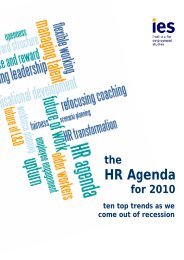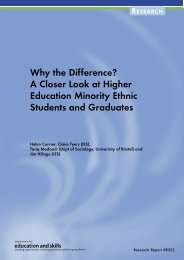Post-16 Transitions: a Longitudinal Study of Young People with ...
Post-16 Transitions: a Longitudinal Study of Young People with ...
Post-16 Transitions: a Longitudinal Study of Young People with ...
You also want an ePaper? Increase the reach of your titles
YUMPU automatically turns print PDFs into web optimized ePapers that Google loves.
introduction <strong>of</strong> a Children’s Bill. The Every Child Matters<br />
agenda proposes a series <strong>of</strong> measures designed to bring<br />
services together: the designation <strong>of</strong> Directors <strong>of</strong> Children’s<br />
Services <strong>of</strong>fering leadership across the Education-Social<br />
Services divide in local authorities, the establishment <strong>of</strong> more<br />
Children’s Trusts bringing a range <strong>of</strong> agencies together <strong>with</strong><br />
pooled budgets, the formulation <strong>of</strong> common targets for<br />
children’s services, the development <strong>of</strong> better informationsharing<br />
systems and so on. These developments are being<br />
taken forward further in respect <strong>of</strong> children <strong>with</strong> SEN through<br />
the government’s new strategy, Removing Barriers to<br />
Achievement (DfES, 2004b). In addition to proposals for<br />
promoting the integration <strong>of</strong> service delivery in line <strong>with</strong> Every<br />
Child Matters, the strategy makes specific commitments to<br />
improve the quality <strong>of</strong> transition planning, set national<br />
standards for the transition from children’s to adult services,<br />
expand educational and training opportunities and develop<br />
new opportunities for transition to work.<br />
The implications for transition are clear. Children and young<br />
people who are identified as having special educational needs<br />
have increasingly in recent years, been able to expect support<br />
to access mainstream pathways and activities rather than<br />
segregation in ‘special’ provision. Beginning at school, they<br />
are more likely to remain in mainstream settings and to have<br />
better-integrated children’s services built around their needs<br />
and wishes. As they approach transition, they have begun to<br />
be supported through a planned transition process, leading to<br />
‘progressive’ education and training and eventually into the<br />
labour market. There, a range <strong>of</strong> programmes and structures<br />
has begun to emerge aimed at enabling them to access<br />
employment opportunities. Two <strong>of</strong> the developments<br />
discussed above should have particular benefits for these<br />
young people ie the creation <strong>of</strong> a more coherent and flexible<br />
further education and training sector; and the establishment <strong>of</strong><br />
a supportive Connexions Service more focused on those at risk<br />
<strong>of</strong> ‘fractured’ transitions. In principle, at least, they should be<br />
less likely to find themselves channelled into ‘dead-end’<br />
segregated provision and supported much more effectively in<br />
making a transition that is recognisably like that <strong>of</strong> their<br />
‘mainstream’ peers.<br />
There are, however, two caveats to note in terms <strong>of</strong> the cohort<br />
who form the subject <strong>of</strong> this study. First, their final years <strong>of</strong><br />
schooling and first years in the post-school world coincide<br />
<strong>with</strong> a period <strong>of</strong> transition in government policy itself. The<br />
government’s inclusion policy, for instance, announced in<br />
1997 (DfEE, 1997b) scarcely had time to take effect before these<br />
young people’s secondary school placements were decided.<br />
Likewise, the Connexions Service, <strong>with</strong> its staggered start, had<br />
no opportunity to make an impact on school-based transition<br />
<strong>Post</strong>-<strong>16</strong> <strong>Transitions</strong> <strong>of</strong> <strong>Young</strong> <strong>People</strong> <strong>with</strong> SEN: Wave 2 15

















